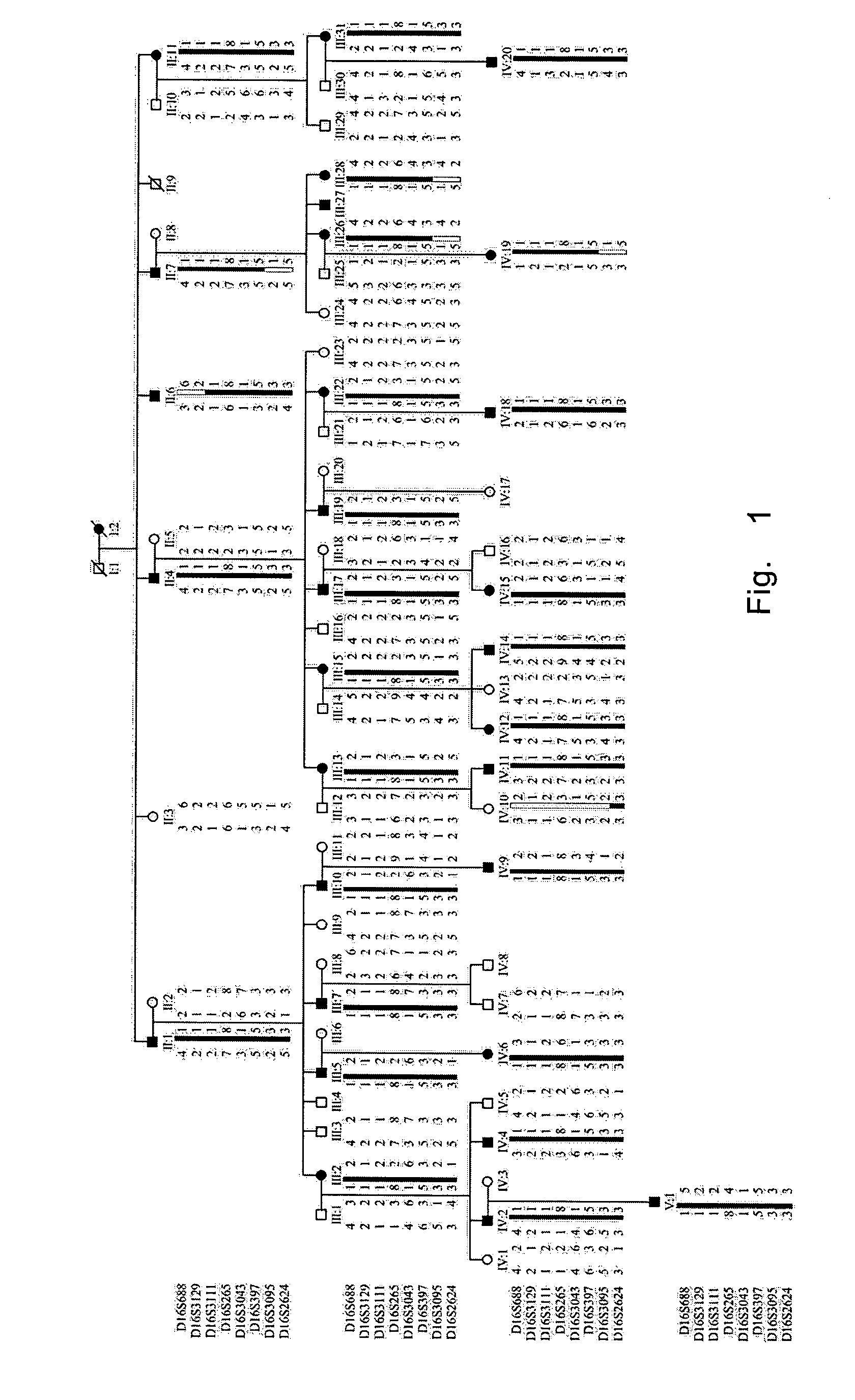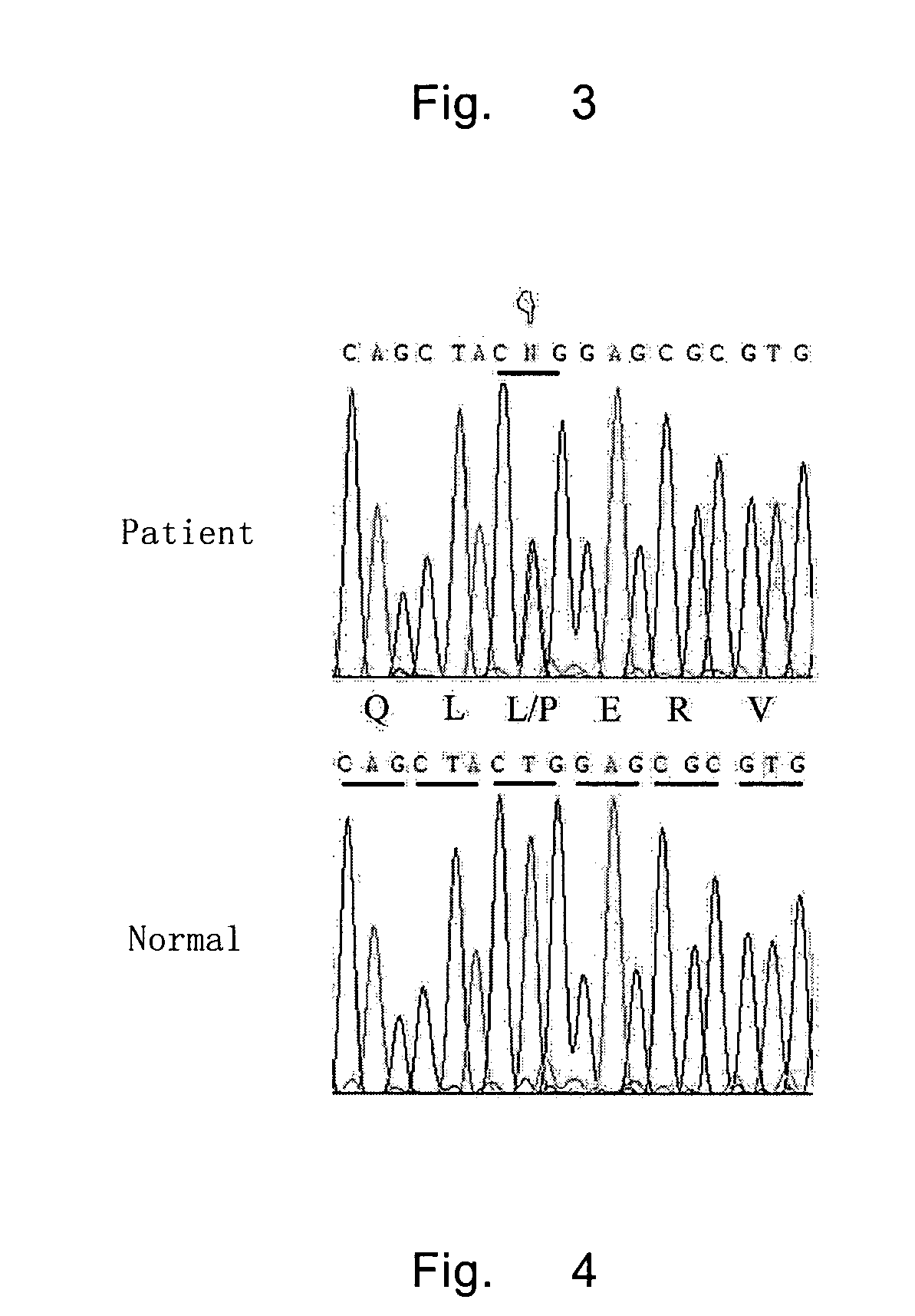Method of diagnosing and treating lens illnesses using human HSF4 gene and coded product thereof
a technology of human hsf4 and lens illness, which is applied in the field of diagnosing and treating lens illness using human hsf4 gene and coded product thereof, can solve the problems of cataract mechanism, lens illness and cataract, and no effective method of diagnosing cataract early
- Summary
- Abstract
- Description
- Claims
- Application Information
AI Technical Summary
Benefits of technology
Problems solved by technology
Method used
Image
Examples
example 1
[0051] The identification of an autosomal dominant cataract family
[0052] 1.1 subject
[0053] We identified a large five-generation Chinese family affected with congenital cataract, total 65 people in this family. Among them, 31 were affected with lamellar cataract (FIG. 1).
[0054] 1.2 Clinical examination
[0055] 1.2.1 Sight
[0056] Examining the naked vision and corrected visual acuity with visual acuity chart.
[0057] 1.2.2 Dilated pupil examination
[0058] Examining lens opacity condition with slit lamp or pocket lamp and observing fundus condition by using direct funduscope.
[0059] In this large Chinese family, the lens opacity was characterized by perinuclear a change, that mean a turbid fetal nucleus surrounded a transparent embryonic nucleus and outside was transparent crystal structure (FIG. 2). Among all the patients investigated, lens opacity has a coincident form and only has a little difference in level, except a ten-month old patient showed a white spot-shaped opacity.
[0060] The di...
example 2
[0075] HSF4 mutation is identified as the direct cause for cataract.
[0076] 2.1 Genetic linkage analysis
[0077] Microsatellite markers were used in the genetic linkage analysis of this family. Totally, 384 microsatillite primers were used to screen the whole genome, we localized the cataract locus onto chromosome 16. By designing more primers, the cataract locus was mapped to the 5.11-cM interval between D16S3129 and D16S3095 (FIGS. 1 and 3). In this region, there are about 7 million base pairs and more than 130 genes.
[0078] 2.2 Candidate gene
[0079] We designed PCR primers to screen candidate genes firstly, then sequenced the PCR products. After sequencing with 9 pairs of primers for HSF4, we found that HSF4 had a close relationship with cataract.
[0080] Sequencing of PCR products generated by two pairs of primers, the products were 483 and 556 bp separately, showed that a T to C transition at nucleotide 348 (SEQ ID NO: 1) of HSF4 mRNA (NM.sub.--001538) in all the affected. This mutati...
example 3
[0083] Cataract detection Kit:
[0084] As FIG. 4 showed: The sequence in normal people is ". . . CTACTG . . . ", while, in cataract family patients, the sequence in one of the two chromosomes changes into ". . . CTACCG . . . ". This mutation is predicted to result in a Leu115Pro substitution, leading to a cataract phenotype. So we designed primers (such as SEQ ID NO: 3, 4, 5 and 6) according to this mutation, and then amplified the DNA samples from patients, finally examined the PCR products,
[0085] Additionally, the sequence "ACTGG" in normal person can be identified by restriction endonuclease "BsrS I". When the T is substituted by C in 348 site, the enzyme cleavage site changes as a result.
[0086] A kit which can be used for 100 samples was prepared which contained the components as shown in the following table:
3 Name Sequence (5'.fwdarw.3') Number Quantity Primer F 5'-agtgctgccccagtatttcaag-3' SEQ ID NO: 7 100 pmol Primer R 5'-gggactgggtcgcaggagca-3' SEQ ID NO: 8 100 pmol BsrS I 10 ...
PUM
| Property | Measurement | Unit |
|---|---|---|
| Composition | aaaaa | aaaaa |
Abstract
Description
Claims
Application Information
 Login to View More
Login to View More - R&D
- Intellectual Property
- Life Sciences
- Materials
- Tech Scout
- Unparalleled Data Quality
- Higher Quality Content
- 60% Fewer Hallucinations
Browse by: Latest US Patents, China's latest patents, Technical Efficacy Thesaurus, Application Domain, Technology Topic, Popular Technical Reports.
© 2025 PatSnap. All rights reserved.Legal|Privacy policy|Modern Slavery Act Transparency Statement|Sitemap|About US| Contact US: help@patsnap.com



